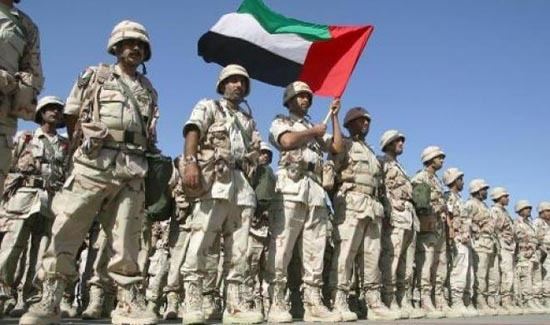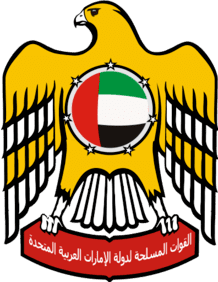Current form 1971 Available for
military service 3,658,577, age 15–49 | Military age 18 years Founded 1951 | |
 | ||
Supreme Commander President Khalifa bin Zayed Al Nahyan Deputy Supreme Commander Crown Prince Mohammed bin Zayed Al Nahyan Chief of staff Lt. General Hamad Mohammed Thani Al Rumaithi Service branches United Arab Emirates Army, United Arab Emirates Navy, United Arab Emirates Air Force Similar United Arab Emirates, Armed Forces of Saudi Ara, Republic of Yemen Armed Fo, Saudi Arabian Army, Kuwait Military Forces | ||
The Union Defence Force (Arabic: القوات المسلحة لدولة الإمارات العربية المتحدة) is the armed forces of the United Arab Emirates and has primary responsibility for the defence of all seven emirates. It consists of 65,000 personnel, and is headquartered in Abu Dhabi, UAE.
Contents
History

The Trucial Oman Scouts, long the symbol of public order on the coast and commanded by British officers, were turned over to the United Arab Emirates as the nucleus of its defence forces in 1971.
Although initially small in number, the UAE armed forces have grown significantly over the years and are presently equipped with some of the most modern weapon systems, purchased from a variety of outside countries, mainly France, the US and the UK (the former protector of the UAE). Most officers are graduates of the United Kingdom's Royal Military Academy at Sandhurst, with others having attended the United States Military Academy at West Point, the Royal Military College, Duntroon and St Cyr, the military academy of France. France opened the Abu Dhabi Base in May 2009. In March 2011, the UAE agreed to join the enforcement of the no-fly-zone over Libya by sending six F-16 and six Mirage 2000 multi-role fighter aircraft. During the Gulf war, the US had troops and equipment stationed in the UAE as well as other parts of the Persian Gulf.
Organization

There are two distinct military organizations in the UAE, the federal military force is called the Union Defence Force, and then several of the Emirates maintain their own forces.
UAE Army
As part of the military of the United Arab Emirates Ground Force is responsible for land operations.
UAE Air Force
The United Arab Emirates Air Force has about 4,000 personnel. The air force agreed in 1999 to purchase 80 US F-16 multirole fighter aircraft. Other equipment includes 60 Mirage 2000s, British Hawk aircraft, and French helicopters. The air defense has a Hawk missile program for which the United States has been training. The UAE has taken delivery of two of five Triad I-Hawk batteries.
UAE Air Defence Force
Responsible for aircraft.
UAE Navy
The United Arab Emirates Navy is growing, with more than 2,000 personnel and 72 vessels.
Paramilitary forces
Former Emirate forces
Four Emirates maintained their own forces prior to the unification of the defence forces. Three were theoretically merged into the Union Defence Force in 1976, but in practice remained under emirate control and procured weapons separately for some time after.
In addition, the Sharjah National Guard was formed in 1972. It was essentially a paramilitary force of 500–600 men with Shorland armoured cars. It merged with the Federal Police in 1976.
Deployments
The UAE sent forces to assist Kuwait during the 1990–1991 Gulf War where several hundred UAE troops participated in the conflict as part of the GCC Peninsula Shield force that advanced into Kuwait City. The US 363rd Tactical Fighter Wing (Provisional) operated from Al Dhafra Air Base in Abu Dhabi, and US ships operated out of UAE ports. The UAE air force also carried out strikes against Iraqi forces. A total of six UAE combat deaths were reported as a result of the fighting.
It dispatched an infantry battalion to the United Nations UNOSOM II force in Somalia in 1993, it sent the 35th Mechanised Infantry Battalion to Kosovo, and sent a regiment to Kuwait during the Iraq War. In addition, it helps protect the Persian Gulf and Strait of Hormuz. It is a leading partner in the campaign against terrorism, providing assistance in the military, diplomatic, and financial arenas. The UAE military provides humanitarian assistance to Iraq.
UAE Military field engineers arrived in Lebanon at 8 September 2007 in Beirut for clearing areas of south Lebanon from mines and cluster bombs. A UAE deployment in Afghanistan started in 2007.
In 2015, the UAE participated in the Saudi Arabian-led intervention in Yemen to influence the outcome of the Yemeni Civil War (2015). On 4 September 2015, forty-five UAE soldiers (together with 10 Saudi and 5 Bahraini soldiers) were killed when a Houthi missile hit an ammunition dump at a military base in Ma'rib Governorate, marking the highest death toll on the battlefield in the country's history.
Military expansion (1991–2005)
The UAE went on an expansion drive in 1995, which began with the 1992–93 acquisition of 436 Leclerc Tanks and 415 BMP-3 Armoured Vehicles. It had learned from the Iranian experiences with having a single supplier for its military and has diversified its arms purchases, purchasing weaponry mainly from Russia, the United States, the UK, Ukraine, France, Italy and Germany. It has also taken care to invest in the systems it has purchased and standardise them according to NATO/GCC Specifications.
The equipment purchases was also followed by a programme to increase manpower numbers and Emiratisation programme for the Armed forces. Presently (2005) almost all pilots in the UAE Air Force are UAE nationals, with the restriction of non-nationals to certain positions in the instruction and maintenance divisions of the airforce. More nationals are being trained to fill these ranks, with programmes such as the Technical Trainee Project underway to try to fill the technical jobs in the country.
There has also been a qualitative shift in the Personnel in the armed services, with expert instruction being brought in from around the world, refinement of local military training institutions and the increase in standards across the armed forces. In 2008, the UAE bought Patriot missiles and related radar, support services for the Patriot systems. There has been work concurrently on the Hawk systems, the Patriots predecessor, currently in use by the UAE.
In the last days of 2011, during a war scare with Iran over the Straits of Hormuz, the UAE announced a purchase of US $3.48 billion worth of American missile systems: 2 radar systems, 96 missiles, spare parts and training. The UAE was the first country to acquire the Terminal High Altitude Area Defense System (THAAD). A contract worth $1.96 billion was agreed for Lockheed Martin Corp to supply two Thaad anti-missile batteries.
Military industry
The UAE has begun to produce a greater amount of military equipment in a bid to reduce foreign dependence and help with national industrialisation. The Abu Dhabi Shipbuilding company - ADSB ([1]) produce a range of ships and are a prime contractor in the Baynunah Programme, a programme to design develop and produce 5–6 corvettes customised for operation in the shallow waters of the Persian Gulf. It has also produced and is producing ammunition, military transport vehicles and Unmanned Aerial Vehicles.
In 2007, the first small arm ever produced in UAE, the Caracal pistol, was introduced at IDEX. It became the official sidearm of the UAE armed forces and security forces. The National Guard of Bahrain adopted it shortly thereafter. Jordan ordered an unspecified number of pistol in April, 2008 during SOFEX, the Special Forces Exhibition held in Jordan. UAE and Algeria established on 17 November 2008 a joint committee in order to test the Caracal pistol for further adoption by Algeria.
A joint venture agreement was signed in Abu Dhabi on 28 November 2007 between Tawazun Holding LLC, an investment company established by the Offset Program Bureau (OPB), Al-Jaber Trading Establishment, part of Al-Jaber Group, and Rheinmetall Munitions Systems, to set up the Al-Burkan munition factory at the Zayed Military City in Abu Dhabi.
The OSP signed four Memorandums of Understanding with leading companies from Europe and Singapore at the Paris Eurosatory 2008 defence exhibition on June 20, Rheinmetall Group and Diehl Defence Holding of Germany, Singapore Technologies Engineering (ST Engg), and Thales of France.
Tawazun has also partnered with Saab on radar development.
